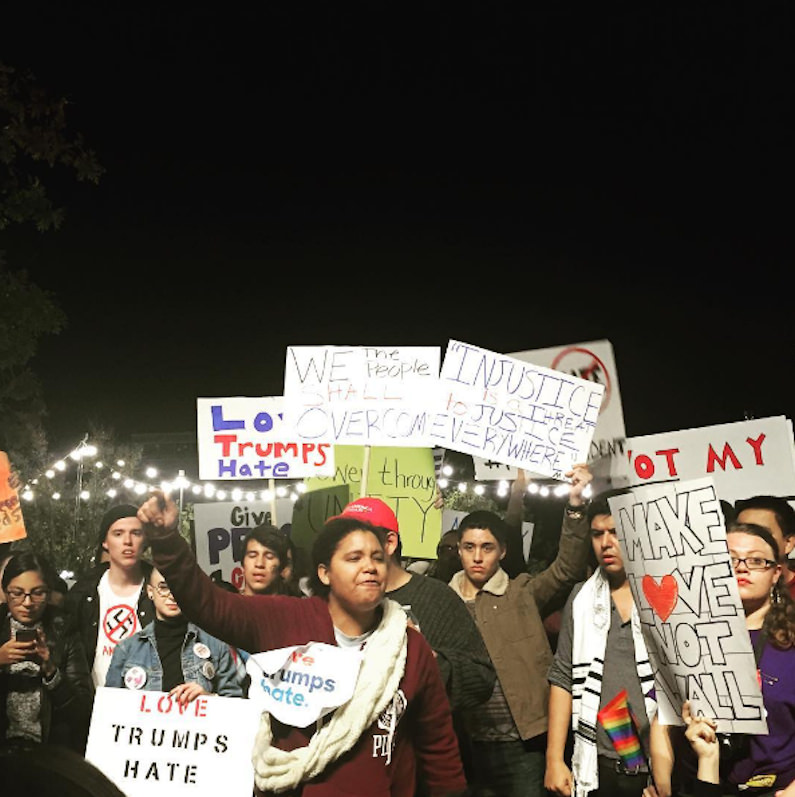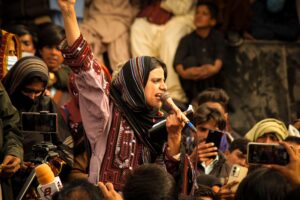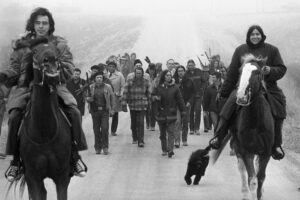Truthdigger of the Week: The Thousands Who Are Peacefully Protesting Trump’s Election
In the days since Donald Trump won the presidency, demonstrators around the country have banded together to oppose the sexism and racism he condoned on the campaign trail.
Anti-Trump demonstrators in El Paso, Texas. (Instagram)
In the late hours Tuesday, it became clear that Donald Trump had been elected the next president of the United States. In the days since, thousands of demonstrations have erupted across the country, and the anti-Trump sentiment shows no signs of quieting down.
The demonstrations span gender, race, religion and geography. From Los Angeles to New York City—and many cities in between—people are using their constitutional right to protest aspects of Trump’s behavior and the result of the chaotic 2016 election.
“We’re ready to stand up and resist the outright sexism, racism and hate that Donald Trump condones,” said Grant Palmer, a protester who took to the streets of downtown Los Angeles on Wednesday night.
As with the recent spate of protests over the Dakota Access pipeline, demonstrators have relied on social media to spread their message and gain national attention. Tools such as Facebook Live and Twitter sparked the trending hashtag “#NotMyPresident” to reflect solidarity.
The Los Angeles demonstrations specifically focused on supporting the city’s large Latino community. Louie Chavez, who also participated in Wednesday’s protest, told Truthdig:
I grew up in isolation being a Mexican-American, gay, dance artist, and I was never urged to stand up for myself or state my mind—rather, to blend in and adapt to a hetero-normative and white-dominated culture. Being surrounded by rainbow flags, Mexico flags, millennials, women … it showed me how many people are just like me. We had rage, we had sadness, and we needed to express it and know our rights are not going to be ignored.
Videos and photos of the Los Angeles protest shared on social media reflect protesters’ anger over Trump’s past rhetoric regarding Latino-Americans:
Downtown Los Angeles tonight. #NOTMYPRESIDENT pic.twitter.com/qEOrfRU9TZ
— Pamela Avila (@bypamelaavila) November 11, 2016
Downtown Los Angeles tonight. #NOTMYPRESIDENT pic.twitter.com/qEOrfRU9TZ
— Pamela Avila (@bypamelaavila) November 11, 2016
In cities across the nation, demonstrators shared the emotional toll of Trump’s victory. It’s no secret that many Americans have despaired since Tuesday night’s election. In the hours after the results became clear, the National Suicide Prevention Lifeline received “two to three times” its normal number of calls, “on a night when calls were already on a dramatic upswing.”
While critics of the post-election protests question whether they will have any effect, demonstrators are banding together for emotional strength.
“Part of why I protested was selfish, perhaps. It was the only thing that eased the grief,” Sienna Gonzalez, a recent graduate, explained about her participation in the New York City protests. “I felt so safe there, but I also felt a rush, because it was inspiring to see the people use their right to protest in the face of this awful election.”
As many as 5,000 people joined the New York City march, which ended outside Trump Tower in Manhattan:
Glad to have participated in today’s protest in New York City. #electionresults2016 pic.twitter.com/MHUqte4uHO
— CL (@LuvFromCL) November 10, 2016
“I think it was important for everyone to get the chance to release emotion,” said Molly Beckett, a student at Columbia College in Chicago who joined the massive protest Wednesday in the Windy City. “The camaraderie was so heartwarming … and I’m feeling so hopeful and determined for the future.”
In Chicago, at least 2,000 demonstrators showed up outside of Trump Tower:
Thousands of anti-Trump protestors are marching through downtown Chicago. Crowd is moving down Michigan Avenue, back towards Trump Tower pic.twitter.com/w5j8NGne2P
— Nereida Moreno (@nereidamorenos) November 10, 2016
Not everyone supports the demonstrations. Although largely peaceful, protests in Portland, Ore., drew national attention after bouts of vandalism and clashes with police spread across the city. And because those protesting are largely liberal, conservatives have been quick to rebuke the show of opposition.
“The reality is, they’re a bunch of spoiled crybabies,” former New York City Mayor Rudy Giuliani said. Milwaukee County Sheriff David Clarke, a potential appointee to Trump’s cabinet, added that the protests “must be quelled.”
“I worry that Trump voters will misunderstand our reasons,” Gonzalez said, noting that her participation in the protests “wasn’t for Hillary.”
“It wasn’t a temper tantrum over losing,” she explained. “It was against our system somehow bringing him to us. It was against the [Democratic National Committee] that broke young Democrats’ motivation with their biased choice in candidate[s]. It was against pollsters who didn’t see this coming. Most of all, it was against the entire political atmosphere we’ve been living in that never did anything about a man who embodies misogyny and bigotry.”
Trump seemed to resent the demonstrations as well, claiming that they were composed of “professional protesters” who were “incited by the media.” He quickly toned down his initial statement, however, later tweeting that he loves “the fact that the small groups of protesters last night have passion for our great country.”
Some have also pointed out that Trump has often encouraged protests as a form of opposition. A handful of tweets over the years show his respect for mass demonstrations:
We can’t let this happen. We should march on Washington and stop this travesty. Our nation is totally divided!
— Donald J. Trump (@realDonaldTrump) November 7, 2012
The organized group of people, many of them thugs, who shut down our First Amendment rights in Chicago, have totally energized America!
— Donald J. Trump (@realDonaldTrump) March 12, 2016
Many Trump supporters raise a crucial question: What are protesters trying to accomplish?
For one thing, demonstrators say, protesting allows various communities—African-Americans, the LGBT community, Muslims and women—to band together. “[This] is a more personal attack,” Chavez said, adding that many Americans are “seeing their government disregard their right to life and prioritize other citizens more than them.”
Protests also allow citizens to support those who are fearful for their very existence under a Trump presidency. “As a white woman in America, I am given an automatic privilege that I need to use by standing by my friends and loved ones,” Marti Skoler, a Chicago protester, explained. “Millennials need to share their voices and band together in any way we can, and right now, that means coming together and rallying.”
Indeed, young people are rallying to the progressive cause, echoing the enthusiastic support Sen. Bernie Sanders received during his campaign for president earlier this year. But, as many millennials note, the opposition to a Trump administration needs to encompass all Americans.
“I think this type of demonstrating is extremely effective, but only if there’s focused leadership,” said Palmer. “If we’re going to make any real change, these leftist political leaders need to connect with the thousands of young people who are ready to act for the cause. They have the direction, we have the manpower. Change is only possible if direction and manpower are combined, so I implore people like Robert Reich and Bernie Sanders to offer direct leadership to these thousands of young activists.”
With a few exceptions, the demonstrations have been peaceful. Gonzalez noted that many of the police officers she saw in New York City “were actually glowing with pride” and even “pointing out their favorite signs to each other.” Mass movements are expected to continue over the weekend, as those around the country prepare themselves for the Trump administration.
“It’s crucial to maintain hope and faith and never stop fighting to create the world we want to see,” Beckett said. “It was so beautiful to see so many people coming together and showing that they care.”
For their peaceful organization and unrelenting voices, the Americans protesting against President-elect Trump are our Truthdiggers of the Week.
Independent journalism is under threat and overshadowed by heavily funded mainstream media.
You can help level the playing field. Become a member.
Your tax-deductible contribution keeps us digging beneath the headlines to give you thought-provoking, investigative reporting and analysis that unearths what's really happening- without compromise.
Give today to support our courageous, independent journalists.






You need to be a supporter to comment.
There are currently no responses to this article.
Be the first to respond.